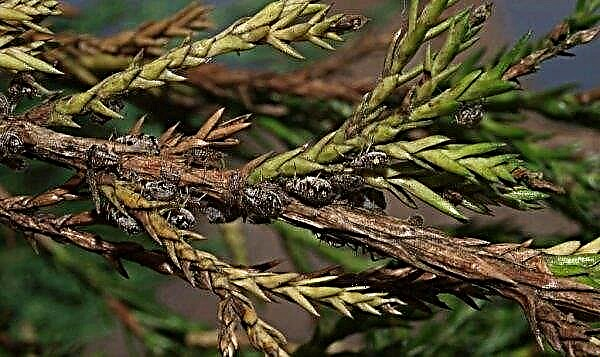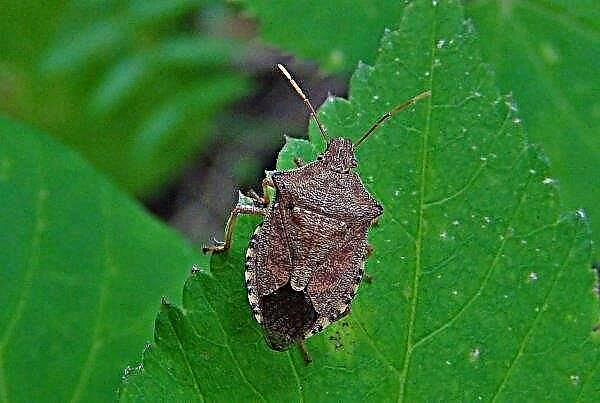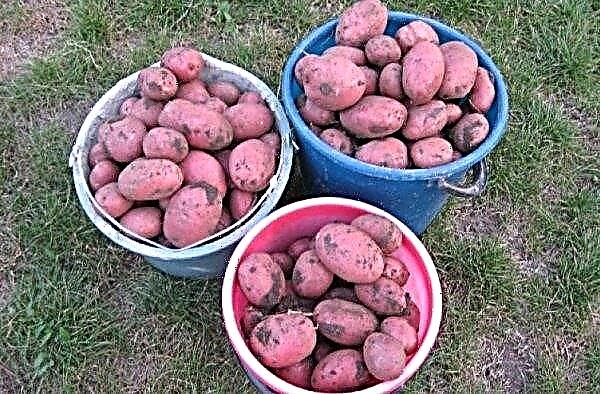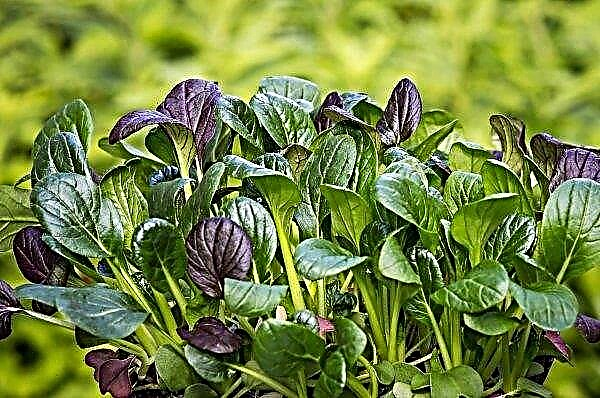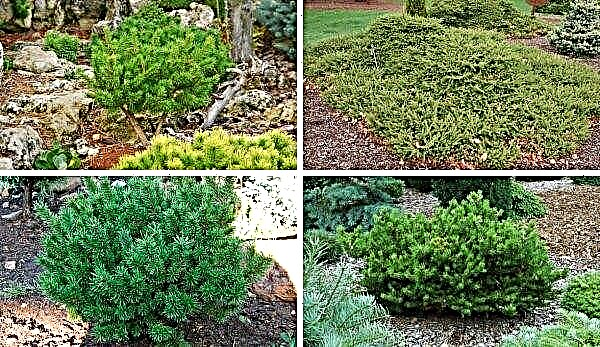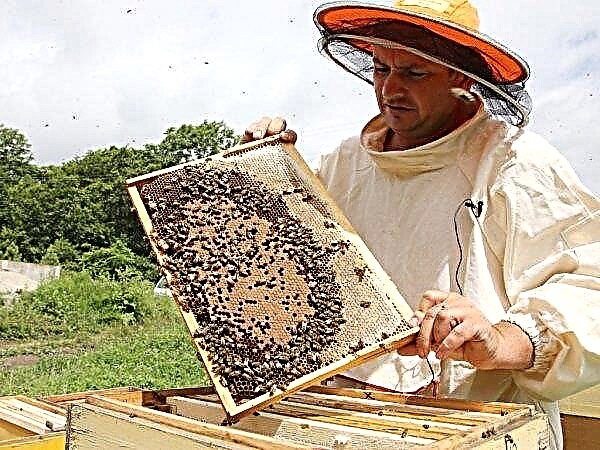Gooseberries are a storehouse of useful elements and vitamins for the human body. Culture has many varieties, each of which has its own characteristics of taste and composition. Their diversity allows you to choose those that will give ideal fruit variations for fresh consumption or will be the basis for jam. One of these varieties is the gooseberry Yubileiny. About him in more detail - later in the article.
Variety description Yubileiny
Jubilee is considered one of the favorite varieties of gooseberries among gardeners. A detailed description of this culture will make it possible to find out the reason for this popularity.
Grade history
Jubilee is considered a fairly old variety. This is a hybrid formed by crossing gooseberries such as Houghton and Bedford yellow. Samples were obtained in 1963 by Russian breeder M.I. Kashkina at the I.V. Michurin All-Russian Research Institute of Horticulture (Michurinsky Nursery). This variety was introduced into the State Register and zoned in the Central Black Earth Region in 1965.
Appearance, characteristics of berries, ripening time, yield
The appearance of gooseberry Yubileiny has the following description:
- Bush. The plant is considered tall. In height, it can reach up to 1.5 m. The growing branched stems of the Jubilee are mostly curved and characterized by medium thickness. Lignified shoots of light color. Sharp spikes have a dark color, double or triple structure and short length. They can cover from 65 to 100% of the bush. Small kidneys on top are pointed, unrefined, and dark in color.
- Leaves. The leaves of the Jubilee are usually of medium size, smooth, with a characteristic dark green color, have an average density. The leaf has five blades, less often three. The edges of the leaves are covered with short teeth. The upper lobe has a blunt edge, it is much larger than the rounded lateral lobes. The leaf is characterized by a straight base and a thin stalk of medium length.
- Flowers. They have a pale color, small size and flattened shape.
- Berries The weight of the fruit can be considered more than average (4-5.5 g). The shape of the fetus is round or slightly oval. Fruits stand out for their amber, bright yellow color. They have many light yellow veins. Fruits are filled with many seeds. Gooseberries have a dessert, sweet and sour taste.

This variety is characterized by an average ripening period (second half of July), high self-fertility and increased fertility. The average yield is 14 tons / ha or a little more than 4 kg of berries from one bush. Although in recent years, the yield of this crop has increased to 6 kg per bush. The regular fruiting process begins from the 2nd – 3rd year of the plant’s life.
Advantages and disadvantages of the variety
Gooseberry Jubilee is a unique hybrid variety that has individual characteristics. According to reviews by gardeners, the main advantages and disadvantages of this variety can be distinguished.
- The plant is characterized by such positive features:
- good yield;
- pleasant sweet and sour taste;
- rich chemical composition;
- high self-fertility.
- Among the main disadvantages of this variety are the following:
- a lot of sharp spikes;
- insufficient frost resistance.
Did you know? The fruits of gooseberry varieties with spikes have a more pleasant taste than those of its non-studded relatives.
Growing Features
In order for the plant to bring a good harvest and not be subjected to various diseases, it is necessary to adhere to the peculiarities of growing these fruit crops.
Seat selection
Gooseberries are a photophilous plant. In darkened places, the growth and development of gooseberries are significantly impaired, the fruits become smaller, and their number is also reduced.
 In well-lit areas, Yubileiny bushes will yield a good crop with large berries.
In well-lit areas, Yubileiny bushes will yield a good crop with large berries.
Gooseberry Yubileiny, like other varieties of this culture, does not like too wet soil. Such soil and high humidity contribute to rotting of the roots, as a result of which the plant dies.
Such places are unacceptable for gooseberries:
- wetland;
- plot with closely spaced groundwater;
- a place with clay soil.
Important! In partial shade, gooseberries will also produce crops, but not as plentiful as in a well-lit area. Although it is possible to plant several shrubs in partial shade, so that after the main crop is harvested from the bushes on the sunny side, you can feast on berries from shaded bushes.
Planting and care, pollination
Planting gooseberries of this variety is carried out according to standard principles for all varieties of this culture. Summer residents and gardeners prefer autumn planting, since in spring you need to choose a certain period - not earlier than thawing the soil and before the buds swell. If you do not get into this spring, the survival rate of the plant will significantly deteriorate. In autumn, it is necessary to plant a culture 1.5–2 months before the onset of frost, then the plant will have time to take root well.
The optimal distance when planting bushes is 1 m for small and medium bushes, 2 m for large samples. The depth and dimensions of the landing pit are prepared in accordance with the size of the plant. A pit measuring 0.5 × 0.5 m is ideal for 1-2 year old seedlings.

Fertilizing the bush during planting is carried out with the following fertilizers:
- 10 kg of manure or fallen leaves;
- 100 g of wood ash;
- 50 g of double superphosphate;
- 40 g of potassium sulfide.
All dry roots and upper parts of the branches need to be cut, and 5-7 buds should be left on the shoots. It is advisable to install the bush under a slight slope, cover it with soil and compact it so that there are no voids. The planting process ends with a thorough watering.
 Plant nutrition takes place in two stages. The first - after flowering shrubs, the second - after harvesting.
Plant nutrition takes place in two stages. The first - after flowering shrubs, the second - after harvesting.
Gooseberries are a self-pollinated culture, which suggests that even one bush will bear fruit. However, for high yields, it is recommended that several gooseberry varieties be planted nearby for cross-pollination. Pollinating insects of this culture - bees, wasps, flies, bumblebees.
Pest and Disease Control
Gooseberry Yubileiny is considered relatively resistant to various diseases, primarily to American powdery mildew.
Gooseberry Yubileiny, unfortunately, is often subjected to the invasion of flames and aphids. To protect the plant from these pests, it is recommended to use biological products or an ash infusion based on wood ash and water (1 kg per 3 l). Such processing is carried out in the spring and additionally after the flowering of the bush.Important! To prevent gooseberry diseases in early April, it is necessary to treat the bushes with boiling water using a watering can and spray.

If gray spots are found on the leaf and shoots of gooseberry Yubileiny, this indicates the presence of powdery mildew. At the first signs of the disease, it is necessary to treat the plantings with a soda solution (5 g of baking soda per 1 liter of water) or a solution consisting of 3 g of iron sulfate diluted in 1 liter of water.
Trimming and shaping a bush
Shrub formation begins in the first years of plant growth. At this time, a significant part of the root shoot is trimmed, and the main perennial branches of the plant are halved.
After the third year, pruning is carried out to eliminate thickening. In this case, all unnecessary, weak, dry shoots are removed. Old shoots are also pruned, because a large percentage of the crop is located on branches 3–6 years old.

Wintering
Gooseberry Yubileiny tolerates wintering well, but in severe frosts, shoot freezing can be observed.
It is necessary to prepare shrubs for winter according to the following rules:
- treat bushes with special pest agents;
- dispose of fallen leaves and weeds;
- dig the soil under the bushes;
- to feed;
- water abundantly.

In winter, shrubs should be in the snow. For winters with little snow, covering the shrub with a special covering material is an excellent option.
Harvesting and transportation
The ripening period of the gooseberry variety Yubileiny falls on the 3-4th decade of July, but harvesting can last for a month (from late July to late August). The fruits grow and ripen at the same time. Berries must be picked when they have acquired an intense amber color, and have become soft to the touch.
This variety perfectly tolerates transportation, while the fruits do not crumple and do not lose their presentation. Shelf life of berries in the refrigerator at a temperature of + 5 ° C - up to 10 days. Much longer fruits can be stored in the freezer (at least a year).Did you know? Gooseberries can bear fruit for more than 20 years under favorable conditions. There are also known cases when bushes at the age of 40 pleased their owners, if not with an abundant, but with a sufficient yield of healthy berries.

Thus, the gooseberry Yubileiny is a unique hybrid variety that has a pleasant taste of fruits and has a good characteristic with many advantages.
Reviews
The first more or less full-fledged crop on new varieties ripened. The jubilee, quite old variety, was bought by me because of the yellow color of the berries, but the second year is not possible to achieve such a color, although now the yellowness on the sunny side is clearly visible. The variety is very prickly, large and fruitful, but it tastes like a middling, ordinary gooseberry taste, without frills, the skin is quite thick.

